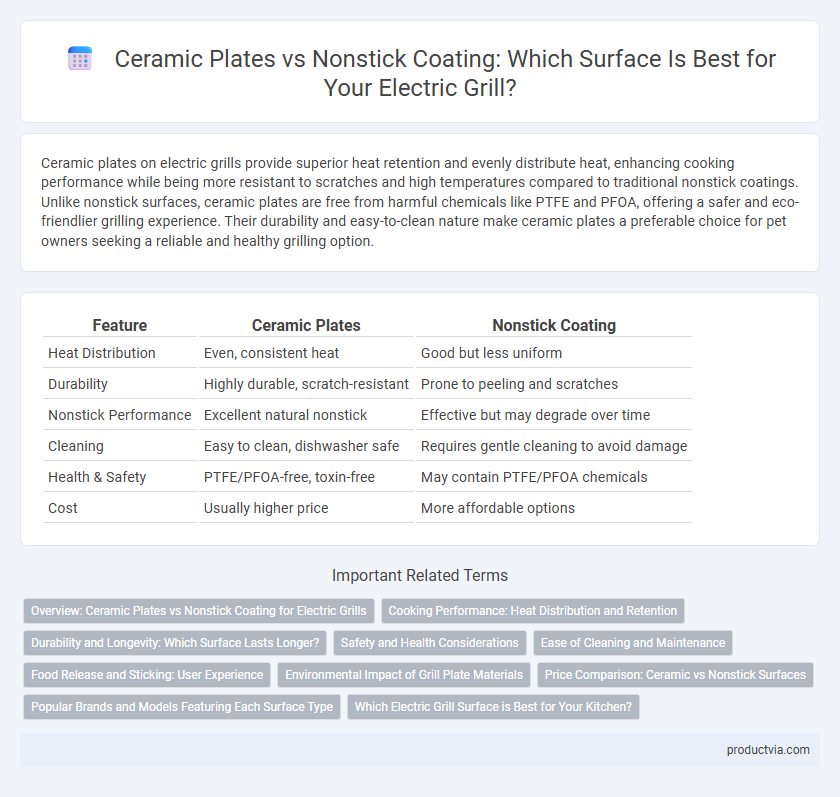Ceramic plates on electric grills provide superior heat retention and evenly distribute heat, enhancing cooking performance while being more resistant to scratches and high temperatures compared to traditional nonstick coatings. Unlike nonstick surfaces, ceramic plates are free from harmful chemicals like PTFE and PFOA, offering a safer and eco-friendlier grilling experience. Their durability and easy-to-clean nature make ceramic plates a preferable choice for pet owners seeking a reliable and healthy grilling option.
Table of Comparison
| Feature | Ceramic Plates | Nonstick Coating |
|---|---|---|
| Heat Distribution | Even, consistent heat | Good but less uniform |
| Durability | Highly durable, scratch-resistant | Prone to peeling and scratches |
| Nonstick Performance | Excellent natural nonstick | Effective but may degrade over time |
| Cleaning | Easy to clean, dishwasher safe | Requires gentle cleaning to avoid damage |
| Health & Safety | PTFE/PFOA-free, toxin-free | May contain PTFE/PFOA chemicals |
| Cost | Usually higher price | More affordable options |
Overview: Ceramic Plates vs Nonstick Coating for Electric Grills
Ceramic plates for electric grills provide a durable, toxin-free cooking surface that resists scratches and maintains heat evenly, enhancing food quality and cleanup ease. Nonstick coating surfaces offer excellent initial non-stick properties and require less oil for healthier grilling but may degrade over time with exposure to high heat and metal utensils. Choosing between ceramic plates and nonstick coatings depends on desired longevity, maintenance preferences, and cooking performance in electric grills.
Cooking Performance: Heat Distribution and Retention
Ceramic plates on electric grills provide superior heat distribution and retention, ensuring food cooks evenly with minimal hot spots. Nonstick coatings offer quick heat transfer but may suffer from uneven temperature maintenance, affecting consistent cooking results. Ceramic surfaces also resist warping under high heat, maintaining optimal performance over extended use.
Durability and Longevity: Which Surface Lasts Longer?
Ceramic plates for electric grills offer superior durability and resist scratches, heat, and chemical damage better than traditional nonstick coatings, resulting in longer-lasting performance. Nonstick coatings tend to degrade faster due to peeling or flaking from frequent heating cycles and metal utensil use. Choosing ceramic surfaces ensures extended longevity, maintaining even cooking and easy cleaning over time.
Safety and Health Considerations
Ceramic plates on electric grills offer a natural, toxin-free surface that resists high temperatures without releasing harmful chemicals, making them a safer option for health-conscious users. Nonstick coatings, typically made from polytetrafluoroethylene (PTFE), can emit toxic fumes if overheated above 500degF (260degC), posing respiratory risks. Choosing ceramic plates reduces exposure to potentially hazardous compounds, ensuring safer grilling and better food safety.
Ease of Cleaning and Maintenance
Ceramic plates on electric grills offer superior ease of cleaning due to their non-porous surface, preventing food particles from sticking and requiring minimal scrubbing. Nonstick coatings also facilitate quick cleanup, but they can degrade over time with frequent use and abrasive cleaning, reducing their effectiveness. Ceramic plates typically provide longer-lasting durability and maintain their smooth surface, making maintenance simpler and extending the grill's lifespan.
Food Release and Sticking: User Experience
Ceramic plates on electric grills offer superior food release due to their naturally nonstick properties, minimizing the need for additional oils and reducing food sticking during cooking. Nonstick coatings also provide effective food release but can degrade over time with scratches or high heat, leading to increased sticking and maintenance concerns. Users often prefer ceramic surfaces for consistent performance and durability, enhancing the overall grilling experience by ensuring easy cleanup and preserving food quality.
Environmental Impact of Grill Plate Materials
Ceramic plates for electric grills offer a more eco-friendly option due to their non-toxic and recyclable properties, reducing harmful chemical runoff compared to traditional nonstick coatings that often contain perfluorinated compounds (PFCs). Nonstick coatings can release toxic fumes and microplastics during wear and disposal, posing significant environmental hazards. Choosing ceramic grill plates supports sustainability by minimizing chemical pollution and promoting longer-lasting, safer grilling surfaces.
Price Comparison: Ceramic vs Nonstick Surfaces
Ceramic plates for electric grills generally come at a higher price point due to their durability and eco-friendly materials, often ranging from $50 to $150, while nonstick coating options are usually more affordable, typically between $30 and $80. Ceramic surfaces offer longer lifespan and resist scratching, which can reduce replacement frequency and overall cost despite the initial investment. Nonstick coatings may require more frequent replacement due to peeling or wear, potentially increasing long-term expenses despite their lower upfront cost.
Popular Brands and Models Featuring Each Surface Type
Popular electric grill brands like Cuisinart and George Foreman frequently use ceramic plates, prized for their durability and even heat distribution, as seen in models such as the Cuisinart Griddler Elite and George Foreman Ceramic Grill. Nonstick coating surfaces dominate in brands like Hamilton Beach and Ninja, with models like the Hamilton Beach Electric Indoor Searing Grill and Ninja Foodi Grill offering easy food release and simple cleaning. Consumers choosing between ceramic and nonstick surfaces often consider brand reputation, with ceramic favored for longevity and nonstick preferred for maintenance convenience.
Which Electric Grill Surface is Best for Your Kitchen?
Ceramic plates offer superior heat retention and chemical-free cooking surfaces, making them ideal for health-conscious users seeking even cooking without harmful emissions. Nonstick coatings provide effortless food release and easy cleanup, perfect for everyday grilling with minimal maintenance. Choosing between ceramic and nonstick depends on priorities such as durability, cooking health, and convenience in your kitchen routine.
Ceramic plates vs nonstick coating for electric grill surfaces Infographic

 productvia.com
productvia.com